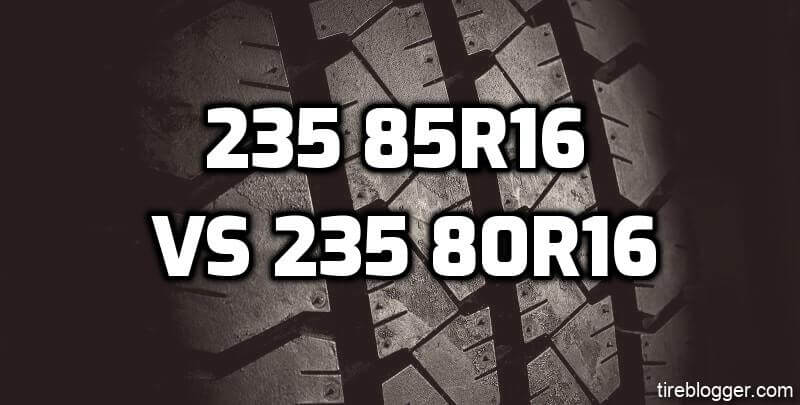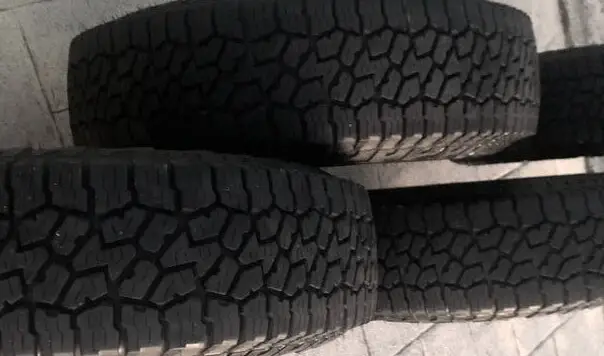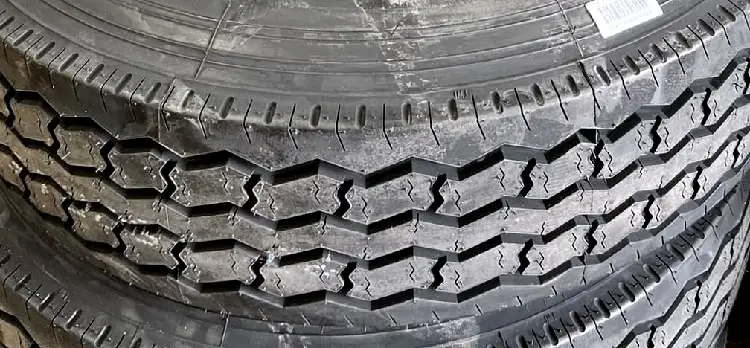Tire Size 235/80r16 vs 235/85r16

The tire sizes 235/80R16 and 235/85R16 are very similar, with the only difference being the aspect ratio. The aspect ratio is a measure of the height of the tire relative to its width, and it is expressed as a percentage.
In this case, the 235/80R16 tire has an aspect ratio of 80%, while the 235/85R16 tire has an aspect ratio of 85%. This means that the 235/85R16 tire is slightly taller and has a larger diameter than the 235/80R16 tire.
235/80r16 vs 235/85r16 Table
For a comprehensive breakdown of the variations between 235/80R16 and 235/85R16 tire sizes, consult this beneficial comparison table.
| Feature | 235/85r16 | 235/80r16 | Difference |
|---|---|---|---|
| Diameter inches | 31.73 (805.9) | 30.8 (782.4) | -0.93 (-23.5) |
| Width inches | 9.25 (235) | 9.25 (235) | 0 (0) |
| Circum. inches | 99.68 (2531.81) | 96.77 (2457.98) | -2.91 (-73.83) |
| Sidewall Height | 7.86 (199.75) | 7.4 (188) | -0.46 (-11.75) |
| Revolutions | 635.65 (394.97) | 654.74 (406.84) | 19.09 (11.86) |
Overall Diameter
The tire’s overall diameter is the total height of the tire, from the bottom of the tread (the part that touches the ground) to the top. The 235/85R16 tire has a diameter of 31.73 inches (805.9 mm), while the 235/80R16 tire has a smaller diameter of 30.8 inches (782.4 mm). This gives a difference of -0.93 inches (-23.5 mm), or a -2.9% reduction.
A larger diameter tire like the 235/85R16 will raise the vehicle higher off the ground, potentially providing more ground clearance, which can be beneficial in off-road scenarios. On the flip side, the smaller diameter of the 235/80R16 could result in better stability and handling at higher speeds because of its lower center of gravity.
Section Width
Width, or section width, is the linear distance across the widest part of the tire, excluding any protective ribs, bars, or decorations. Both the 235/85R16 and 235/80R16 tires have a width of 9.25 inches (235 mm).
The identical width means that both tires should provide similar contact patch with the road, leading to comparable traction and grip levels.

Circumference
The tire’s circumference is the distance around the outer edge of the tire. The 235/85R16 tire has a larger circumference of 99.68 inches (2531.81 mm), whereas the 235/80R16 tire has a smaller circumference of 96.77 inches (2457.98 mm). The difference is -2.91 inches (-73.83 mm) or -2.9%.
A larger circumference can affect the vehicle’s speedometer reading, making it slightly lower than the actual speed. This is because a larger tire covers more ground per revolution. Therefore, the vehicle’s actual speed with the larger tire would be higher than indicated.
Sidewall Height
The sidewall height is the distance from the rim to the tread. For the 235/85R16 tire, the sidewall height is 7.86 inches (199.75 mm), while the 235/80R16 has a lower sidewall height of 7.4 inches (188 mm), equating to a difference of -0.46 inches (-11.75 mm) or -5.9%.
A taller sidewall can absorb more shocks from road imperfections, providing a smoother ride. However, it can also result in more lateral movement, which can reduce handling precision. A shorter sidewall, as seen on the 235/80R16, would provide better handling and stability but might compromise on ride comfort.

Revolutions Per Mile
Revolutions per mile is the number of times a tire rotates in one mile. The 235/85R16 tire has fewer revolutions per mile at 635.65, whereas the 235/80R16 tire has more at 654.74. This difference means that for every mile, the smaller tire will rotate approximately 19.09 more times than the larger one.
A higher revolution per mile figure indicates that the tire will wear faster, as it has to rotate more times to cover the same distance. This could lead to more frequent tire changes for the 235/80R16 compared to the 235/85R16.
Construction Type
Both tires are of radial construction, denoted by the ‘R’ in their size. Radial tires are the most common type and offer good durability, heat dissipation, and fuel efficiency.
Alternative Tire Size of 235/80r16
The overall diameter of the replacement tires must not exceed or fall short of the original tires by more than 3%.
| Tire Size | Overall Diameter | Difference |
|---|---|---|
| 255/70R16 | 30.1″ (764 mm) | -2.3% |
| 275/65R16 | 30.1″ (764 mm) | -2.3% |
| 215/85R16 | 30.4″ (772 mm) | -1.3% |
| 245/75R16 | 30.5″ (774 mm) | -1% |
| 285/65R16 | 30.6″ (776 mm) | -0.8% |
| 265/70R16 | 30.6″ (778 mm) | -0.5% |
| 345/55R16 | 30.9″ (786 mm) | 0.5% |
| 225/85R16 | 31″ (788 mm) | 0.8% |
| 295/65R16 | 31.1″ (790 mm) | 1% |
| 275/70R16 | 31.2″ (792 mm) | 1.3% |
| 265/75R16 | 31.7″ (804 mm) | 2.8% |
Alternative Tire Size of 235/85r16
The replacement tires must adhere to a 3% tolerance in overall diameter compared to the original tires.
| Tire Size | Overall Diameter | Difference |
|---|---|---|
| 235/80R16 | 30.8″ (782 mm) | -3% |
| 345/55R16 | 30.9″ (786 mm) | -2.5% |
| 225/85R16 | 31″ (788 mm) | -2.2% |
| 295/65R16 | 31.1″ (790 mm) | -2% |
| 275/70R16 | 31.2″ (792 mm) | -1.7% |
| 265/75R16 | 31.7″ (804 mm) | -0.2% |
| 285/70R16 | 31.7″ (806 mm) | 0% |
| 225/90R16 | 32″ (812 mm) | 0.7% |
| 375/55R16 | 32.2″ (818 mm) | 1.5% |
| 265/80R16 | 32.7″ (830 mm) | 3% |
Our Observation
Both the 235/85R16 and 235/80R16 tires are well-suited for vehicles requiring larger tires, like light trucks, SUVs, or off-road vehicles. The choice between them depends on your specific needs and driving conditions.
The 235/85R16 with its larger diameter, circumference, and sidewall height would offer better ground clearance, making it an excellent choice for off-road driving. It also provides a smoother ride due to the larger sidewall. However, the larger size could affect speedometer readings and fuel efficiency.
The 235/80R16, with its smaller diameter and sidewall height, offers superior handling and stability, especially at high speeds. It might wear out faster due to more revolutions per mile, but this could be a suitable trade-off for better on-road performance.
In summary, consider your driving style, vehicle type, and terrain before making a decision. Regardless of the choice, ensure to maintain proper tire pressure for optimal performance and longevity.

Meet Caitlin McCormack, a Tire Size Expert and Blogger Passionate About Everything Related to Tires. With Years of Experience in the Tire Industry, Caitlin Has Become an Expert in Tire Sizes and Their Impact on Vehicle Performance.
